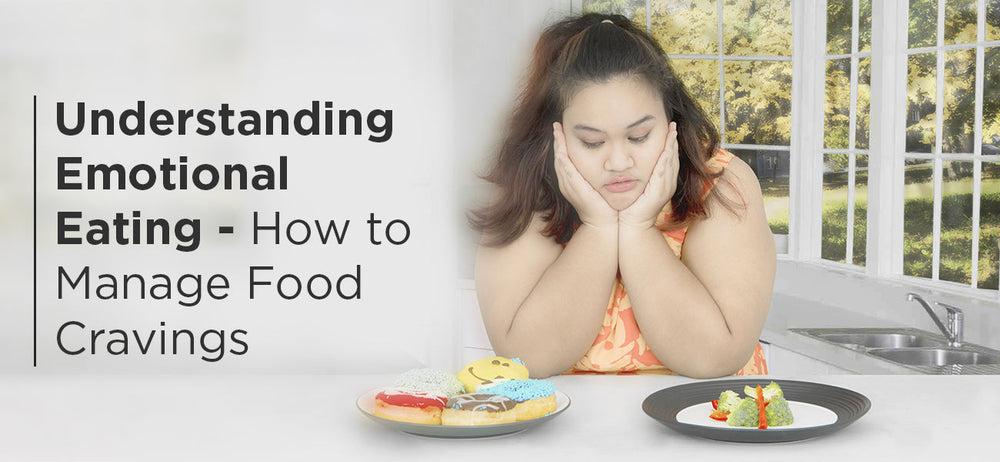Imagine coming home after a long, stressful day and immediately reaching for a bag of chips or that hidden stash of chocolate. You are not truly hungry, but the urge to snack feels overwhelming, almost automatic. This is a familiar scenario for many people dealing with emotional eating - a response to feelings like stress, boredom, or sadness rather than physical hunger. From sugar cravings at night to the constant battle with junk food, emotional eating can feel difficult to control and leave you feeling frustrated.
Emotional eating is a common struggle for many, where food becomes a response to stress, boredom, or other emotions rather than hunger. For those who feel stuck in a cycle of reaching for snacks to cope with feelings, managing these food cravings can seem challenging. However, understanding the primary cause of emotional eating can develop a healthier relationship with food.
In this blog, we will discuss how to manage food cravings effectively, uncovering the triggers behind emotional eating and practical steps to create a healthier relationship with food.
What is Emotional Eating?
Emotional eating is the practice of using food to manage emotions instead of satisfying physical hunger1. This behaviour often leads people to reach for high-calorie, sugary, or processed foods that may provide comfort in the short term but often result in feelings of guilt or frustration afterward. People who say, "I can't stop eating junk food" or struggle with boredom eating may experience emotional eating patterns. This behaviour is not uncommon, but it can impact both physical and mental health over time.
Stress eating and comfort eating are often driven by the brain’s response to certain triggers. When the body perceives stress, it releases cortisol, the “stress hormone,” which can increase cravings for high-sugar or high-fat foods. Eventually, turning to food to cope can develop into an emotional eating disorder1.
Signs of Emotional Eating
Emotional eating may seem similar to regular hunger, but it has distinct characteristics2. Recognizing these signs can help you identify and manage food cravings more effectively:
- Sudden Cravings: Emotional hunger occurs suddenly, often as a craving for comfort foods, whereas physical hunger builds gradually.
- Eating Without Hunger: Emotional eaters might reach for food to satisfy boredom, stress, or other emotions, not actual hunger.
- Craving Specific Foods: Emotional cravings are often for sugary or high-fat foods that provide immediate pleasure but lack nutritional value.
- Difficulty Stopping: Many emotional eaters feel it is difficult to stop once they start. This may be followed by guilt or shame, which can perpetuate the cycle.
Understanding these signs is the first step in learning how to manage food cravings and reduce the impact of emotional eating on overall well-being.
Common Reasons of Emotional Eating
Emotional eating can have several triggers. Recognizing these triggers can help you find healthier ways to cope.
Recognizing your personal triggers can be the first step toward reducing emotional eating patterns.
Tips to Manage Food Cravings
Here are a few practical tips to help curb emotional eating:
- Recognize the Difference Between Emotional and Physical Hunger4
Analyze whether you are genuinely hungry. Physical hunger can be satisfied by a wide range of foods, while emotional hunger often demands specific comfort foods. If you are craving something specific like sweets or junk food, ask yourself if you are actually hungry or if it is an emotional response.
- Identify and Address Triggers
Understanding your triggers is crucial to manage emotional eating. If stress or boredom frequently leads to cravings, find alternatives to distract yourself. For example:
By identifying these emotional triggers, you can work towards finding healthier ways to cope.
- Develop Healthy Coping Mechanisms
Healthier alternatives can provide similar relief without causing any side effects:
- Improve Your Eating Routine
A balanced eating routine can help reduce cravings. Eating at regular intervals and including protein and fiber-rich foods can promote satiety, making it easier to resist sugar cravings and other temptations. Foods high in protein and fiber provide longer-lasting energy, reducing the likelihood of sugar cravings 7,8.
How to Manage Specific Food Cravings
Certain cravings, such as those for sugar or fried or fatty foods, are more common in emotional eating. Here are tips on how to manage these specific cravings:
How to Stop Sugar Cravings
Sugar cravings are one of the most common challenges, often intensified by stress or fatigue. To stop sugar cravings:
Managing Cravings for Junk Food
If you feel, “I can’t stop eating junk food,” try these tips:
Ways to Break the Cycle of Emotional Eating
Long-term changes in behaviour and mindset are essential for overcoming emotional eating patterns. Here are some approaches to build a healthier relationship with food5:
- Practice Mindful Eating
Mindful eating encourages awareness around eating habits, allowing you to make conscious choices rather than acting on impulse. Take time to savour each bite, listen to hunger cues, and stop when you feel satisfied. This practice can reduce the likelihood of boredom eating and make it easier to recognize emotional triggers.
- Set Realistic Goals
Setting attainable goals helps reduce feelings of stress or demotivation, which can trigger emotional eating. Instead of drastic dietary restrictions, aim to build balanced meals with plenty of nutrients, which can help manage cravings naturally.
- Seek Support
If you are struggling with an emotional eating disorder or stress eating disorder, consider seeking support from a therapist or a nutrition coach. Professional guidance can help address underlying issues and provide tools to manage emotions without turning to food.
- Include Supplements Wisely
Some supplements may help balance mood and reduce cravings. Magnesium, for example, can help with sugar cravings10 and stress11. Including supplements in your routine, as recommended by a healthcare professional, can help manage stress and support healthier eating habits.
Emotional eating can be daunting to break, but understanding your triggers. By practising mindful eating, developing healthy coping mechanisms, and building a balanced eating routine, you can better manage food cravings and create a positive relationship with food.
With a mindful approach to food and emotional awareness, it is possible to overcome stress eating patterns and adopt healthier habits for long-term well-being. Remember, emotional eating is a common experience, but with the right approach, you can regain control over cravings and follow a more balanced lifestyle.
References
- Ha, O., & Lim, S. (2023). The role of emotion in eating behavior and decisions. Frontiers in Psychology, 14. https://doi.org/10.3389/fpsyg.2023.1265074
- Reichenberger, J., Schnepper, R., Arend, A., & Blechert, J. (2020). Emotional eating in healthy individuals and patients with an eating disorder: evidence from psychometric, experimental and naturalistic studies. Proceedings of the Nutrition Society, 79(3), 290–299. https://doi.org/10.1017/s0029665120007004
- Dakanalis, A., Mentzelou, M., Papadopoulou, S. K., Papandreou, D., Spanoudaki, M., Vasios, G. K., Pavlidou, E., Mantzorou, M., & Giaginis, C. (2023). The Association of Emotional Eating with Overweight/Obesity, Depression, Anxiety/Stress, and Dietary Patterns: A Review of the Current Clinical Evidence. Nutrients, 15(5), 1173. https://doi.org/10.3390/nu15051173
- Meule, A. (2020). The Psychology of Food Cravings: the Role of Food Deprivation. Current Nutrition Reports, 9(3), 251–257. https://doi.org/10.1007/s13668-020-00326-0
- Sun, W., & Kober, H. (2020). Regulating food craving: From mechanisms to interventions. Physiology & Behavior, 222, 112878. https://doi.org/10.1016/j.physbeh.2020.112878
- Yoshikawa T, Tanaka M, Ishii A, Watanabe Y. Association of fatigue with emotional-eating behavior and the response to mental stress in food intake in a young adult population. Behavioral medicine. 2014 Oct 2;40(4):149-53.
- Ortinau, L. C., Hoertel, H. A., Douglas, S. M., & Leidy, H. J. (2013). The impact of a protein‐rich breakfast on food cravings and reward in overweight/obese ‘breakfast skipping’ adolescent girls. The FASEB Journal, 27(S1). https://doi.org/10.1096/fasebj.27.1_supplement.1075.9
- Ohlsson, B., Darwiche, G., Roth, B., Bengtsson, M., & Hoglund, P. (2017). High fiber fat and protein contents lead to increased satiety reduced sweet cravings and decreased gastrointestinal symptoms independently of anthropometric hormonal and metabolic factors. Journal of Diabetes & Metabolism, 08(03). https://doi.org/10.4172/2155-6156.1000733
- Gannon, M. C., Nuttall, F. Q., Saeed, A., Jordan, K., & Hoover, H. (2003). An increase in dietary protein improves the blood glucose response in persons with type 2 diabetes. American Journal of Clinical Nutrition, 78(4), 734–741. https://doi.org/10.1093/ajcn/78.4.734
- Sugar and Fat: Cravings and Aversions, Yanovski, Susan. The Journal of Nutrition, Volume 133, Issue 3, 835S - 837S
- Cuciureanu, M. D., & Vink, R. (2011). Magnesium and stress. Magnesium in the Central Nervous System - NCBI Bookshelf. https://www.ncbi.nlm.nih.gov/books/NBK507250/










